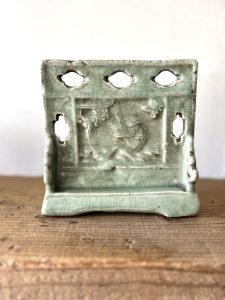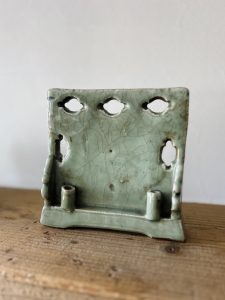友達のように大切に扱われた文房具たち(愛知県名古屋市千種区姫池通 骨董買取 古美術風光舎)
2024.08.03
皆さまこんにちは。スタッフHでございます。
眩しすぎる日差しが降り注ぐなか、買ったばかりのサングラスがいくら探しても見当たらず落ち込んでおります。きっと日差しが弱まってきた時期に、こんなところに!という場所から登場するのでしょう。新しく購入するか悩むところです。
オリンピックでは連日熱戦が続いていますね。出場している訳ではないのに観戦した後はかなりの疲労感を感じてしまいます。選手たちの長年の努力の結晶の瞬間に便乗させていただいて、勝手に一喜一憂させていただいております。
メダルを獲得した試合も感動的なのですが、なぜか敗れた選手たちが鮮明に記憶に残っていきます。年齢のせいでしょうか?
余談が多くなりましたが、本日は店内に新しく陳列されております光沢が美しい若草色のお品に朝から見入っておりました。七官青磁の「硯屏(けんびょう)」と呼ばれるものです。中央に浮き上がる龍の表情に愛嬌を感じ、引き込まれ、硯屏として使わずとも目に入るところに飾っておきたくなります。小ぶりなお品ですが存在感があり、ずっしりとした重量感もあります。

七官青磁は中国明末時代から清時代にかけて龍泉窯で焼かれた青磁を指し、光沢の強い青緑色を帯び、貫入があるのが特徴とされています。
硯屏とは文字からも想像できる通り、硯(すずり)の側に立て、風や塵などを防ぐ小さな衝立のことで、風光舎の硯屏も高さ15cmほどの大きさです。背面に筒状の筆立てが二本あり機能性も抜群の文房具です。

文房具と書きましたが、実は「文房」はもともと中国で「書斎」を意味し、「文房に備えておく道具」から「文房具」と呼ばれるようになったとのこと。
もとは文房に置かれていた硯、筆、紙、墨、筆洗、筆筒、水滴、文鎮などに加え、琴や屏風、書画や陶器などの美術品も含めて文房具と呼ばれていたそうです。
その後、宋の時代に文字を書くために必要な筆・硯・墨・紙の4点のみが「文房四宝」や「四友(ゆう)」と呼ばれるようになったとのこと。「宝」という漢字や入っていることや文房具を「友」とまで言い表していたことから、この4種類がいかに珍重されていたかが分かりますね。宋の時代には文房具に関する書物もまとめられていたとか。
その当時の文房具は実用品としてよりも鑑賞用としての意味合いが強く、特に硯は半永久的に使えることから他の3つに比べて価値が高いとされていたそうです。
その大切な硯を守るべく作られた硯屏。風光舎の七官青磁の硯屏も時代を超えて大切に扱われてきたのではないでしょうか。
日本に文房具が広まったのは610年頃に高句麗から伝わったと言われ。正倉院の宝物としても数多くの文房具類が納められています。時代とともに装飾が凝らされ、中国と同様に日本でも文房具は観賞用としての意味合いが強かったようですが、明治時代以降、西洋文化の波が押し寄せると欧米の紙類や筆記用具など実用品として広まっていきました。
今では日本は文房具先進国とも言われ、種類も豊富で書きやすいペン類などは海外へのお土産に大変喜ばれるとか。
機能だけではなく、遊び心満載の文房具が日々更新され、文具売り場などは楽しくてかなりの時間を過ごせてしまいます。
スマホで何でもこなせてしまう時代ですが、無くなってほしくないもののひとつです。
それでは、また次の機会に。
Hello everyone. This is Staff H.
The sun is shining brightly, and I am depressed because I cannot find the sunglasses I just bought, no matter how hard I look for them. I am sure that they will appear in such a place when the sun’s rays are getting weaker! I am wondering if I should buy a new pair. I am wondering whether I should buy new sunglasses or not.
The Olympic games have been going on day after day. Even though I am not participating in the games, I feel quite exhausted after watching them. I am happy and sad to be a part of the moment of the crystallization of the athletes’ longtime efforts.
The games in which the athletes won medals are also very moving, but for some reason, the defeated athletes remain vivid in my memory. Is it because of my age?
I could go on and on, but I was looking at the new items on display in the store today, which have a beautiful young grass-colored luster. It is called an “inkstone screen” of Shichikan celadon porcelain. The expression of the dragon floating in the center of the inkstone screen is so charming that it draws you in and makes you want to display it where you can see it, even if you do not use it as an inkstone screen. Although small in size, it has a strong presence and a heavy weight.
Celadon porcelain produced at the Longquan kilns during the late Ming and Qing dynasties in China is characterized by its luster, blue-green color, and the fact that it is pierced.
As the characters suggest, an inkstone screen is a small stand that stands next to the inkstone to protect it from wind and dust, and the Fuhkosha inkstone screen is about 15 cm tall. The Fuhkosha inkstone screen is about 15 cm high. It is also a highly functional piece of stationery with two tubular brush stools on the back.
The word “stationery” was originally used in China to mean “study,” and the word “stationery” was derived from the Chinese word “bunbou,” meaning “a tool to be kept in a writing room.
Originally, the term “stationery” included not only inkstones, brushes, paper, ink, brush washes, brush tubes, water droppers, paperweights, etc., but also art objects such as zithers, folding screens, paintings and calligraphy, and ceramics.
Later, in the Sung dynasty. Only the four items necessary for writing, namely the brush, inkstone, inkstick, and paper, came to be called the “four treasures of writing” or “four friends (yu). The Chinese character for “treasure” and its inclusion, and the fact that the stationery was even referred to as “friend,” shows how highly prized these four types of items were. In the Song dynasty, books on stationery were also compiled.
At that time, stationery was more for appreciation than for practical use, and inkstones in particular were considered more valuable than the other three because they could be used semi-permanently.
The inkstone screens were made to protect these important inkstones. Fuhkosha’s Chikan celadon inkstone screens must have been treated with great care throughout the ages.
It is said that stationery spread to Japan from the Koguryo Dynasty around 610. Many stationery items are housed as treasures in the Shosoin Repository. As in China, stationery in Japan, like in China, had a strong connotation of being for ornamental purposes.
Today, Japan is said to be an advanced stationery country, and its wide variety of pens and other easy-to-write products are highly appreciated as souvenirs from abroad.
The stationery department is full of new stationery products that are not only functional but also full of fun, and you can spend a lot of time there.
We live in an age where we can do just about anything with our smartphones, but it is one of the things we don’t want to see go away.
I’ll see you next time.
*******************
ご実家の整理やお片付けなどをされている方のご相談などが多くございます。
お片付けなどくれぐれもご無理のないようになさってくださいませ。
風光舎では古美術品や骨董品の他にも絵画や宝石、趣味のお品など様々なジャンルのものを買受しております。
お片付けをされていて、こういうものでもいいのかしらと迷われているものでも、どうぞお気軽にご相談下さいませ。
また風光舎は、出張買取も強化しております。ご近所はもちろん、愛知県内、岐阜県、三重県その他の県へも出張いたします。
まずは、お電話お待ちしております。
愛知県名古屋市千種区姫池通
骨董 買取【古美術 風光舎 名古屋店】
TEL052(734)8444
10:00-18:00 OPEN
#出張買取#骨董#古美術#骨董品#絵画#版画#茶道具#刀剣#彫刻

